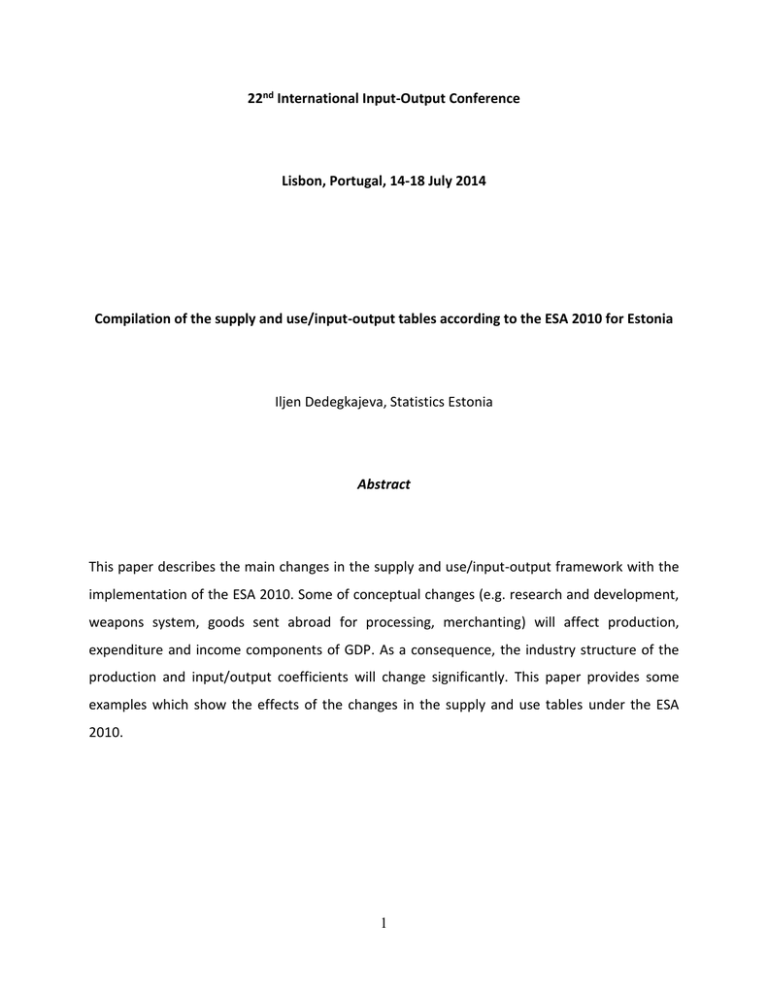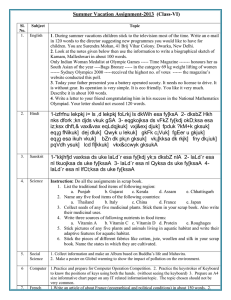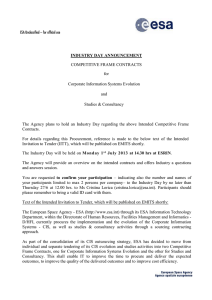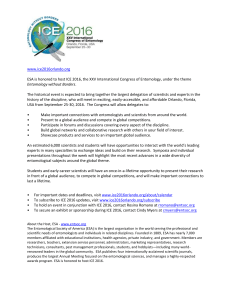The development of Supply and Use Tables in Constant Prices
advertisement

22nd International Input-Output Conference Lisbon, Portugal, 14-18 July 2014 Compilation of the supply and use/input-output tables according to the ESA 2010 for Estonia Iljen Dedegkajeva, Statistics Estonia Abstract This paper describes the main changes in the supply and use/input-output framework with the implementation of the ESA 2010. Some of conceptual changes (e.g. research and development, weapons system, goods sent abroad for processing, merchanting) will affect production, expenditure and income components of GDP. As a consequence, the industry structure of the production and input/output coefficients will change significantly. This paper provides some examples which show the effects of the changes in the supply and use tables under the ESA 2010. 1 Introduction In September 2014 Statistics Estonia, like all other EU member states, will carry out a major revision of the national accounts in accordance with the new European System of National Accounts (ESA 2010). Adoption of the new ESA guidelines is obligatory for all member states of the European Union. Many of the changes in definition from the old ESA 1995 guidelines, to the ESA 2010 have an impact on Gross Domestic Product (GDP) and its components. The most important adjustments in this revision concern research and development (R&D) expenditure, military expenses. These will hence be included in investments. In addition, there are a number of definitional changes which only affect the data by industry or by transactions, and not the economy as a whole. For instance, with the implementation of the ESA 2010, the treatment of goods for processing from abroad changes and consequently the data on imports and exports will decrease significantly, however the effect on the GDP is null. The Estonian national accounts figures will be revised, using 2010 as the base year. Changes in definitions and data sources will be fully implemented in the supply and use/input-output framework (SUT/IOT for the year 2010 according to the ESA 1995 have been already published). The first results of the revised version of the national accounts for the period 2000-2013 will be published in September 2014. The supply and use tables for the years 2010 and 2011 and symmetric input-output tables for the year 2010 according to the ESA 2010 will be published in December 2014. In this paper, the major changes in the supply and use/input-output tables due to the revision of the Estonian national accounts are discussed. The effects of the changes on the level of the figures are analysed and the difference between the figures before and after revision are explicitly shown. 2 The major changes in the supply and use tables from the ESA 1995: 1. Recording of research and development as fixed capital formation 2. Recording of military weapons systems as fixed capital formation 3. “Net” recording of goods sent abroad for processing 4. The recording of merchanting 3 RESEARCH AND DEVELOPMENT The treatment of research and development in the ESA 1995 The recording of market output of R&D services in the supply table is presented in table 1. Market output of R&D services is produced by market R&D producers (specialised commercial research institutes in NACE 72 and by non-specialised corporations as secondary production in various industries). Output by market producers is valued at the revenue from sales, contracts, commissions or fees. Non-market units, such as state universities and also non-profit research institutes produce non-market R&D services and also have income from sales of R&D services. 456 1 413 1 951 127 0 Total Domestic Supply at purchasers prices 127 Taxes less subsidies 721 1 230 Trade margins 183 1 230 Imports Total Domestic Supply at basic prices 456 Market RD Industry 2 …………. … Non-market RD Products Product 1 Product 2 R&D market R&D non-market …………. Total Industry 1 Industries Table 1. The supply table for 2010 according to the ESA 1995, mln.EEK 22 870 1 230 22 2 100 Under ESA 1995, expenditures on research and development (R&D) services by non-financial and financial corporations and institutions in general government and NPISH sectors are by definition recorded as intermediate consumption (table 2). Table 2. The use table for 2010 according to the ESA 1995, mln.EEK 4 R&D non-market …………. Total Exports Total final uses 6 Changes in inventories 645 GFCF HCE 38 NPISH Total Intermediate Consumption 122 GG Non-market RD 8 Market RD Industry 2 2 …………. Industry 1 Industries Products Product 1 Product 2 R&D market 219 870 1 230 2 8 122 38 645 6 1 230 1 230 219 2 100 The new treatment of research and development in the ESA 2010 The main change in ESA 2010 is recognising the products R&D services as capital assets. This will affect several entries in the SUT. From now, the internal R&D-activities of research departments of corporations are explicitly recorded as secondary activity (and not ancillary activity) of the relevant industries. They produce own-account R&D services that is capitalised by themselves. 5 5 10 10 150 150 456 5 127 127 22 0 22 Total Domestic Supply at purchasers prices Taxes less subsidies 721 995 1 969 3 685 Trade margins 183 995 1 153 2 331 Imports Total Domestic Supply at basic prices Market RD …………. Industry 2 456 Non-market RD Products Product 1 Product 2 R&D market R&D non-market R&D own-account Total Industry 1 Industries Table 3. The supply table for 2010 according to the ESA 2010, mln.EEK 870 995 1 969 3 834 The own-account R&D output is recorded in the use table as gross fixed capital formation. The own-account output of RD is capitalized as intellectually property products. In the production approach, the output of market producers increases (when R&D service is produced internally) or the intermediate consumption decreases (when R&D is purchased). 485 964 219 870 995 1 969 219 3 834 31 1 969 160 6 964 31 2 454 0 Total final uses Exports Changes in inventories GFCF 6 NPISH 160 GG HCE Products Product 1 Product 2 R&D market R&D non-market R&D own-account …………. Total Total Intermediate Consumption Non-market RD Market RD …………. Industry 2 Industry 1 Industries Table 4. The use table for 2010 according to the ESA 2010, mln.EEK As a consequence, GDP has increased in 2010 by 2 219 mln.EEK (1.0% of GDP). Gross fixed capital formation has increased by 2 454 mln.EEK. The government final consumption decreased by 266 mln.EEK and NPISH final consumption increased by 31 mln.EEK. 6 WEAPONS SYSTEMS The military weapons systems, such as warships, submarines, military aircraft, tanks, missile carriers and launchers, etc. are used in processes of production for defence services for more than one year, even if their peacetime use is simply to provide deterrence. Under ESA 1995, purchases of weapons systems by military authorities in general government sector were by definition recorded as intermediate consumption (table 5). Products Military product 1 Military product 2 Military product 3 Total 753 50 60 863 753 50 60 863 Total final uses Exports GFCF Changes in inventories NPISH GG HCE Total Intermediate Consumption …………. …………. Public administartion and defence Industry 2 Industry 1 Industries Table 5. The use table for 2010 in accordance with the ESA 1995, mln.EEK 753 50 60 863 In new ESA 2010, purchases of durable weapons systems by military authorities in general government sector are considered as gross capital formation (table 6). Products Military product 1 Military product 2 Military product 3 Total 0 753 50 60 863 7 Total final uses Exports GFCF Changes in inventories NPISH GG HCE Total Intermediate Consumption …………. …………. Public administartion and defence Industry 2 Industry 1 Industries Table 6. The use table in accordance with the ESA 2010, mln.EEK 753 50 60 863 Since defence is general government non-market production, where the output value is estimated as the sum of the costs, the effect on GDP is equal to the resulting change in the consumption of fixed capital (825 mln.EEK), whilst government consumption changes by the amount of the difference between the reclassified purchase of goods and the change in the consumption of fixed capital (-38 mln.EEK). Table 7. Changes in the accounts for general government for 2010, mln.EEK PRODUCTION APPROACH Output of goods and services (at basic prices) Intermediate consumption (at purchasers' prices) Gross value added (at basic prices) Taxes on products Subsidies on products 2010 -38 -863 825 0 EXPENDITURE APPROACH Total final consumption expenditure Household final consumption expenditure NPISH final consumption expenditure General government final consumption expenditure Gross capital formation Gross fixed capital formation Changes in inventories Acquisitions less disposals of valuables Exports of goods and services Imports of goods and services -38 0 0 -38 863 863 0 0 0 0 As a consequence, GDP has increased in 2010 by 825 mln.EEK (0.4% of GDP). Gross fixed capital formation has increased by 863 mln.EEK. The output value and the government consumption decreased by 38 mln.EEK. 8 GOODS SENT ABROAD FOR PROCESSING Cross-border processing activities are quite significant in Estonia. About half of manufacturing enterprises involved in contract processing performs work for the non-resident's units. Foreign trade statistics also shows that the gross values of goods sent for processing (particularly inward processing) are significant (please refer to diagram 1). Diagram 1. Imports for inward processing in total imports of goods for 2000-2008 100% 90% 80% 70% 60% 50% 40% 30% 20% 10% 0% Goods for processing Ordinary imports The treatment of goods for processing in the ESA 1995 Goods sent abroad for processing are recorded “gross” in the national accounts. Goods sent abroad for processing are defined as materials or semi-processed goods belonging to a principal enterprise in country A which are shipped to a foreign processor in country B for significant transformation and then returned to the principal in country A. The goods do not change ownership from A to B and B receives from A a fee for processing the goods. 9 In the supply and use tables, goods sent abroad for processing are included under goods. In case of inward processing, such goods are shown as imports of goods sent from abroad for processing and classified in a different group of the CPA. The value of the goods sent for processing was accounted for 7771 mln.EEK in 2008 (table 8). The processed goods re-exported back become new goods (for instance, transformation of fabric into clothing) and are valued at a higher value as a result of the processing. The value of the goods after processing was estimated at 9869 mln.EEK in 2008. Table 8. Supply and use table for 2008 according to ESA 1995, mln.EEK Product 1 Product 2 ………. Inventories Changes in Total Exports industry consumption by Imports Output Goods for processing: Goods processed: Use Intermediate Supply 7 771 7 402 370 7 771 500 490 10 500 1 700 1 700 1 700 ….. 9 856 9 869 Product 3 800 800 Product 4 2 500 2 510 -13 9 856 10 2 500 ………. In the production account, the value of the goods sent for processing is allocated to intermediate consumption of importing (processing) industry. The value of gross output of that industry is equal to the value of the material and the processing fee. In other words, output is adjusted by the value of exports of processed goods and intermediate consumption by the value of imports of goods for processing. The treatment of goods for processing in the ESA 2010 10 Goods sent abroad for processing are recorded “net” in the national accounts and flows are classified as services (processing fee). The value of goods sent for processing and processed goods are not included in the accounts. Processing fees are shown under production of services on the supply side and as exports of services on the use side. In the production account, the value of goods to be processed is not included in intermediate consumption. Value added in the processing economy is unaffected. Production is classified as a service, not a good. Table 9. Supply and use table for 2010 according to ESA 2010, mln.EEK Processing fees - Inventories Changes in Total Exports industry consumption by Imports Output Goods for processing Goods processed Use Intermediate Supply - - - 2 455 2 455 2 455 The processing fee received from the principal enterprise for the work performed was estimated at 2455 mln.EEK in 2008 on the basis of SBS and PRODCOM. Under the ESA 2010, the industry structure in the processing country will change significantly. The ratios of intermediate consumption and value added to gross output of the manufacturing industries engaged in the processing under ESA 1995 and ESA 2010 in 2010 are presented in table 3 below. The biggest changes in the ratios of intermediate consumption to gross output were observed for industries of manufacture of electrical equipment (-5.3%) and manufacture of textiles, wearing apparel and leather product (-4.8%). Table 10. Differences in the structure by industry for year 2010 due to revision of the ESA 2010, mln.EEK 11 Code M.C.10_11 M.C.13_15 M.C.16 M.C.17 M.C.18 M.C.19 M.C.20 M.C.21 M.C.22 M.C.23 M.C.24 M.C.25 M.C.26 M.C.27 M.C.28 M.C.29 M.C.30 M.C.31_32 M.C.33 Activity Manufacture of food products and beverages Manufacture of textiles, wearing apparel and leather product Manufacture of wood and of products of wood and cork, except Manufacture of paper and paper products Printing and reproduction of recorded media Manufacture of coke and refined petroleum products Manufacture of chemicals and chemical products Manufacture of basic pharmaceutical products and pharmaceuti Manufacture of rubber and plastic products Manufacture of other non-metallic mineral products Manufacture of basic metals Manufacture of fabricated metal products, except machinery a Manufacture of computer, electronic and optical products Manufacture of electrical equipment Manufacture of machinery and equipment n.e.c. Manufacture of motor vehicles, trailers and semi-trailers Manufacture of other transport equipment Manufacture of furniture; other manufacturing Repair and installation of machinery and equipment 12 ESA2010 IC ratio to output ESA1995 IC ratio to output Difference 77,9% 78,4% -0,6% 63,5% 68,4% -4,8% 74,2% 74,7% -0,5% 67,9% 68,2% -0,3% 66,8% 66,9% -0,1% 58,6% 59,1% -0,5% 73,4% 73,8% -0,4% 71,3% 71,9% -0,6% 73,3% 73,6% -0,3% 67,1% 78,4% 67,5% 78,4% -0,5% -0,1% 73,0% 73,5% -0,4% 85,7% 71,1% 86,2% 76,4% -0,4% -5,3% 67,1% 67,6% -0,6% 68,7% 69,8% -1,1% 65,0% 65,6% -0,5% 67,6% 69,0% -1,4% 60,7% 61,0% -0,3% MERCHANTING The treatment of merchanting in the ESA 1995 Merchanting is defined as the purchase of a good by a resident of the compiling economy from a non-resident and the subsequent resale of the good to another non-resident. During this process the good does not enter or leave the compiling economy. Merchanting margin is calculated as the value of the goods sold less the cost of purchasing them. In the supply and use tables in accordance with the ESA 1995, the merchanting margin is recorded under the product of wholesale trade by the industries engaged in the merchanting activities. In 2010, the total amount of merchanting margins by industries calculated from the supply side accounted for 2948 mln.EEK. The contribution of wholesale trade industry was 2296 mln.EEK (78% of total product output). Merchanting margin produced by other activities was estimated at 652 mln.EEK (22%). Total Domestic Supply at purchasers prices Taxes less subsidies Trade margins Total Domestic Supply at basic prices Wholesale trade 2 296 2 948 2 948 10 343 2 296 2 948 2 948 Imports 343 …………. 10 …………. Industry 2 Products Product 1 Product 2 …………. Wholesale trade …………. Total Industry 1 Industries Table 11. Supply table for 2010 according to ESA 1995, mln.EEK In the use table, the merchanting is recorded as an export of services under the product wholesale trade. 13 Total final uses GFCF Changes in inventories NPISH Exports Products Product 1 Product 2 …………. Wholesale trade …………. Total GG HCE Total Intermediate Consumption …………. Wholesale trade …………. Industry 2 Industry 1 Industries Table 12. Use table for 2010 according to ESA 1995, mln.EEK 2 948 2 948 2 948 2 948 The treatment of merchanting in the ESA 2010 Merchanting is recorded on a gross basis. The acquisition of goods (imports) by the merchant is recorded in the accounts as a negative export, and the subsequent sale of the goods as a positive export, the difference between sales and purchases of merchanted goods is to be shown as net exports of goods under merchanting. In the ESA 2010, the output of merchanting activities is allocated to the product wholesale trade across the industries where the production took place. In contrast to ESA 1995 recording, the total output for this product is then redistributed across the products categories (CPA) in the trade margin column (table 13). Table 13. Supply table for 2010 according to ESA 2010, mln.EEK 14 10 343 2 296 2 948 152 1 357 … -2 948 10 343 2 296 2 948 0 Total Domestic Supply at purchasers prices Taxes less subsidies Trade margins Imports Total Domestic Supply at basic prices …………. Wholesale trade …………. Industry 2 Industry 1 Industries Products Product 1 Product 2 …………. Wholesale trade …………. Total 152 1 357 2 948 0 The recording of merchanting in the use table is presented in table 14. The merchanting margin is allocated across the products by CPA at purchasers’ prices. Products Product 1 Product 2 …………. Wholesale trade …………. Total 15 Total final uses Exports Changes in inventories GFCF NPISH GG HCE Total Intermediate Consumption …………. Wholesale trade …………. Industry 2 Industry 1 Industries Table 14. Use table for 2010 according to ESA 2010, mln.EEK 152 1 357 … 0 152 1 357 2 948 2 948 0





